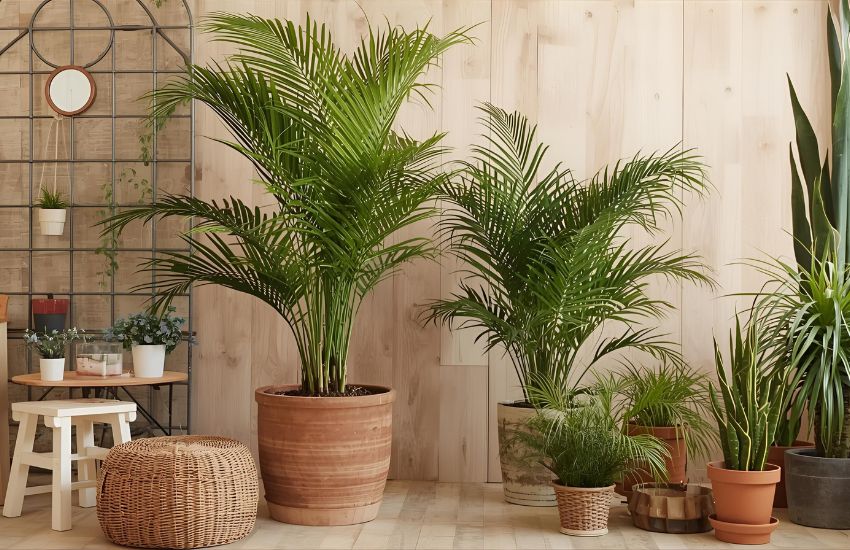Looking for a timeless, low-maintenance palm that adds graceful greenery to your space? The parlor palm known botanically as Chamaedorea elegans might be exactly what you need. This elegant indoor houseplant, native to Mexico and Guatemala, is celebrated for its lush fronds, air-purifying qualities, and ability to thrive in low light. Whether you’re a new grower or refining your indoor plant care routine, understanding the unique needs of the parlor palm will help you avoid issues like brown leaf edges, yellow leaves, or root rot.
Parlor palm care is simple yet essential for healthy growth. Place it in indirect light, water when the top inch is dry, and maintain moderate humidity. Use well-draining potting mix, avoid overwatering, and repot sparingly. With proper care, this elegant indoor plant thrives beautifully year-round.
With the right palm care, this slow-growing beauty can flourish for years. You’ll learn how to provide the proper water, avoid overwatering, maintain the ideal humidity, and repot only when necessary. We’ll also touch on how to prune carefully, choose the right potting mix, and keep pests like spider mites at bay. If you’ve ever struggled with brown leaf tips, cold drafts, or finding the best indirect light, this guide will offer clarity.
In this complete guide to parlor palm care, you’ll discover how to create the perfect indoor environment, prevent common problems, and support healthy foliage throughout the growing season.
How to Repot, Prune, and Water Your Parlor Palm Plant

Caring for your parlor palm plant requires attention to a few essential routines that support long-term health and beauty. In this complete guide, you’ll find professional advice on how to repot the plant, trim it with care, and manage a healthy watering schedule ensuring your palm stays lush, vibrant, and free from issues like yellow or brown fronds or browning leaf tips.
When and How to Repot the Plant
Although a slow grower, the parlor palm occasionally needs a larger container to continue thriving. You should repot the plant only when it becomes root-bound typically every 2 to 3 years. Choose a well-draining potting mix to help the plant to prevent root rot, and always use a container with drainage holes to avoid buildup of excess water. For best results, repot during spring, the start of the growing season.
Pruning to Remove Dead or Yellow Fronds
While parlor palm plants don’t require heavy pruning, you may remove any yellow fronds, dry leaf tips, or damaged stems to maintain a tidy appearance. Always use clean, sharp scissors to snip at the base without disturbing healthy foliage. Occasional trimming helps your indoor parlor palm direct energy toward new, healthy growth and prevents browning tips from spreading.
Watering Based on Light and Indoor Conditions
Proper watering is essential to care for parlor palm and other types of palm. Allow the soil dry slightly between waterings, and never let the plant sit in excess water. In lower light conditions, your palm will require less water, while increased light or dry indoor air may cause faster evaporation.
Check the top inch of soil before watering if it’s dry, it’s time to water. Using room-temperature water helps prevent shock. To keep your parlor palm healthy, avoid overwatering, which causes leaves to turn yellow and encourages fungal issues.
Conclusion
Successfully growing a parlor palm plant indoors depends on consistent, mindful care. From knowing when to repot the plant to trimming yellow fronds and managing water needs in varying light conditions, each step contributes to long-term health and beauty. By following this complete guide, you’ve gained the knowledge to care for parlor palm confidently preventing browning leaf tips, avoiding excess water, and maintaining ideal humidity levels even in low-light or dry air environments.
Whether you’re nurturing a new plant or improving your existing routine, these care instructions ensure your indoor parlor palm remains vibrant and stress-free throughout the year. Remember, every action from selecting the right potting mix to applying liquid fertilizer plays a role in supporting your palm’s natural elegance.
Explore more of our expert tips and continue your journey to master indoor plant care starting with the next chapter of our Grow-How series!
Frequently Asked Questions (Grow-How Tips Parlor Palm Care: Complete Guide to Thriving Palm Plants)
Is Parlor Palm easy to care for?
Yes, the Parlor Palm is one of the easiest indoor palms to care for. It tolerates low light, average humidity, and infrequent watering, making it perfect for beginners. With proper care, it grows slowly but steadily, adding elegant greenery indoors.
How often should I water my Parlor Palm?
Water your Parlor Palm when the top 1–2 inches of soil feel dry. Overwatering can cause root rot, so always use a well-draining pot. In winter, reduce watering since the plant grows more slowly.
Does Parlor Palm need sunlight or shade?
Parlor Palms thrive in bright, indirect light but also tolerate low-light conditions. Avoid direct sunlight, as it can scorch the fronds. A north or east-facing window is ideal for balanced growth.
Why are my Parlor Palm leaves turning brown?
Brown leaf tips often result from low humidity, overfertilization, or underwatering. Mist the plant occasionally, avoid harsh fertilizers, and keep watering consistent to prevent browning.
